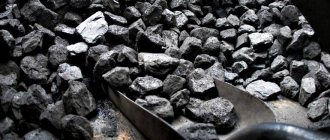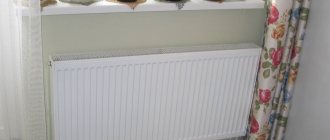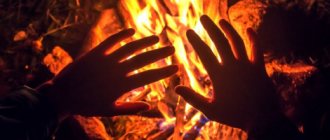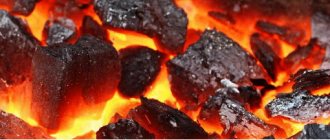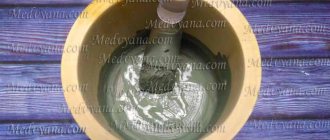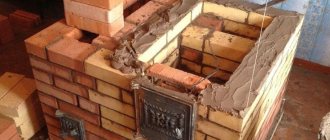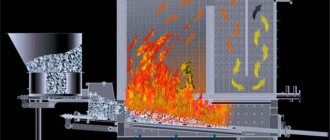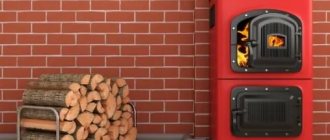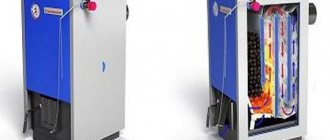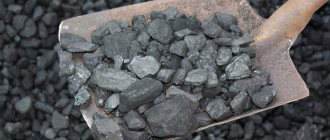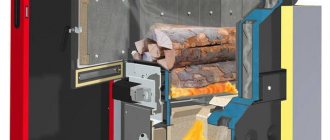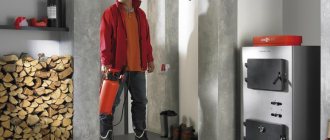Today, there are several types of solid fuels that are used as an energy carrier. Such fuel is: wood, coal, various fuel briquettes, as well as peat. Coal is considered the best fuel that can ensure the efficiency of a furnace or boiler. Today, charcoal is widely used, as well as fossil fuels. The popular charcoal is produced only artificially, namely through wood processing, but nature itself creates fossil fuels. Both types are widely used in some industries, as well as in everyday life.
Coal combustion: its varieties and their characteristics
Today, the most common solid fuel raw materials are wood and coal. However, coal is much superior to wood in terms of combustion time, and its heat transfer rates are also higher. With all this, much less coal is consumed than firewood.
Wood has long been used to heat homes, but fuels such as coal are beginning to displace it from use. This is because charcoal produces much more heat than wood and remains burning longer.
Coal has its own varieties, which have different qualities and characteristics. Each species has its own depth, as well as a different method of extraction.
Type of fossil fuel:
- Anthracite;
- Coal;
- Brown coal.
The youngest deposits are brown coal. This type of coal contains a large amount of moisture (40%) and volatile substances (50%), but there is very little carbon in its composition (50 - 70%). The usual combustion temperature of young rock is slightly higher than wood and is 350 degrees, and the heat of combustion of brown coal is 3500 kcal/kg. The use of coal can be considered the most common. Its combustion temperature is 470 degrees, at which about 7000 kcal/kg of heat is released, and this is due to the high carbon content, more than 75%, and only 13 - 15% moisture. The last type remains - anthracite. This is the most difficult to obtain fuel and very expensive. However, it is the most efficient of all known types of solid fuel that can be extracted from the bowels of the earth. Its combustion temperature is 500-600 degrees and this is not the limit; in some cases it can reach 2250 degrees, and the heat of combustion can be 8350 kcal/kg.
Types and grades of coal
Coal is classified according to many parameters (geography of extraction, chemical composition), but from a “domestic” point of view, when buying coal for use in furnaces, it is enough to understand the labeling and the possibility of use in ThermoRobot.
According to the degree of coalification, three types of coal are distinguished: brown
,
stone
and
anthracite.
The following coal designation system is used:
Grade
= (
grade)
+ (
size class).
In addition to the main grades given in the table, intermediate grades of coal are also distinguished: DG (long-flame gas), GZh (gas fatty), KZh (coke fatty), PA (semi-anthracite), brown coals are also divided into groups. Coking grades of coal (G, coke, Zh, K, OS) are practically not used in thermal power engineering, since they are a scarce raw material for the coke-chemical industry. According to the size class (size of pieces, fractions), graded coal is divided into:
In addition to graded coal, there are combined fractions and screenings available for sale (PK, KO, OM, MS, SSh, MSSh, OMSSh). The size of coal is determined based on the smaller value of the finest fraction and the larger value of the largest fraction indicated in the name of the coal grade. For example, the OM fraction (M - 13–25, O - 25-50) is 13–50 mm.
In addition to the above-mentioned types of coal, you can find coal briquettes on sale, which are pressed from low-enriched coal slurry.
How coal burns
Coal consists of two flammable components: volatiles
and
solid (coke) residue
.
During the first stage of combustion, volatile substances are released; When there is an excess of oxygen, they burn quickly, producing a long flame but little heat.
After this, the coke residue burns out; the intensity of its combustion and ignition temperature depend on the degree of coalification, that is, on the type of coal (brown, hard, anthracite). The higher the degree of carbonization (the highest is for anthracite), the higher the ignition temperature and heat of combustion, but the lower the combustion intensity.
Coal grades D, G
Due to the high content of volatile substances, such coal flares up quickly and burns out quickly. Coal of these grades is available and suitable for almost all types of boilers, however, for complete combustion, this coal must be supplied in small portions so that the released volatile substances have time to completely combine with oxygen in the air. Complete combustion of coal is characterized by a yellow flame and clear flue gases; incomplete combustion of volatile substances produces a purple flame and black smoke. To effectively burn such coal, the process must be constantly monitored; this operating mode is implemented in the Termorobot automatic boiler room.
Coal grade A
It is more difficult to light, but it burns for a long time and produces much more heat. Coal can be loaded in large batches, since they burn mainly coke residue and there is no mass release of volatile substances. The blowing mode is very important, since if there is a lack of air, combustion occurs slowly, it may stop, or, on the contrary, an excessive increase in temperature, leading to heat loss and burnout of the boiler.
Everyone knows that fuel use plays a huge role in our lives. The fuel is used in almost every branch of modern industry. Fuel derived from oil is especially often used: gasoline, kerosene, diesel fuel and others. Combustible gases (methane and others) are also used.
Coal combustion formula: two types of fuel
When combustion of any fuel, wood or coal, occurs, a chemical reaction occurs, resulting in the formation of heat. There is an equation for this reaction, which results in the formation of carbon monoxide (formula CO). The combustion does not end there; the whole process rises, where the reaction between carbon monoxide and oxygen occurs. Then combustion is expressed by a bright blue flame and, along with this, heat is released.
Carbon monoxide, which is formed at the end of the entire combustion process, escapes through the chimney. The heat generated as a result is evenly distributed throughout the room. Fuel is used to achieve this result.
Fuel (coal) is divided into two types: short-flame and long-flame. Long-flame fuel can burn in two stages. The first stage is the combustion of volatile gases formed above the coal layer, and then the remaining fuel in the form of coke. Coke burns with a distinctive short flame. As a result, after all the carbon has burned out, slag and ash remain.
Short flame fuel:
- Coke;
- Anthracite;
- Charcoal.
When burning a short-flame type, a large amount of heat is generated. Short-flame anthracite burns odorless and smokeless, without forming a residue, and is also characterized by a low flame.
Using Charcoal
In everyday life, charcoal is used to cook meat on the grill.
Thanks to the high combustion temperature (about 700°C) and the absence of flame, uniform heat is provided, sufficient for cooking meat without charring.
It is also used as fuel for fireplaces and cooking on small stoves.
In industry, it is used as a reducing agent in metal production. Charcoal is indispensable in the production of glass, plastics, and aluminum.
Pyrolysis furnace: charcoal burning temperature
Charcoal is not a fossil at all. This fuel is produced by humans in special pyrolysis furnaces. The process of obtaining it is quite simple and consists of processing wood by pyrolysis. Simply put, you need to remove all moisture from the wood.
A pyrolysis oven has 4 main components: a very strong base, a combustion chamber, a secondary processing compartment and a chimney. The whole process takes place inside the combustion chamber, where it is necessary to constantly maintain the desired temperature and control the oxygen supply.
During the entire smoldering process, a lot of heat is generated, and moisture evaporates and evaporates. The smoke that is produced is recycled in a special compartment and burns completely there, generating heat.
Stages of producing charcoal:
- The critical stage is drying;
- The most important is pyrolysis;
- Then - calcination;
- And finally - cooling.
Charcoal begins to ignite at a temperature of 100 - 200 degrees, and flares up to 800 - 900. When it burns, a sufficient amount of heat is released that can warm the room.
Application
The main use of fuel is to burn it to produce heat. Heat is used not only for heating a private home and cooking, but also in industry to support technological processes that occur at high temperatures.
Unlike a conventional stove, where the process of oxygen supply and combustion intensity is poorly regulated, in industrial stoves special attention is paid to controlling the supply of oxygen and maintaining a uniform combustion temperature.
Let's consider the basic scheme of coal combustion.
- The fuel heats up and moisture evaporates.
- As the temperature rises, the coking process begins with the release of volatile coke gases. When burned, it provides the main heat.
- Coal turns into coke.
- The coke combustion process is accompanied by the release of heat sufficient to initiate coking of the next portion of the fuel.
In industrial boilers, the combustion of coke is separated into different chambers from the combustion of coke oven gas. This allows the flow of oxygen for coke and gas at different intensities, achieving the required combustion rate and maintaining the required temperature.
Application of brown coal and charcoal: areas of use
Brown coal is the cheapest among other types of fuel. Therefore, it is widely used in everyday life and some industry. For example, in the chemical industry, for the production of soot, gasoline, semi-coke, mining wax, as well as their processing.
Charcoal, like brown charcoal, is in great demand. It is used in everyday life for frying meat on the grill or grill. This type of fuel is also used for cains or small stoves on which various foods can be cooked.
This fuel has brought very great environmental benefits. Charcoal, today, is considered an environmentally friendly fuel and at the same time completely safe. Therefore, it is widely used in many industries.
Use of this coal in industry:
- In the production of very rare and valuable metals;
- Used in gas masks as a trap for harmful substances;
- Purify gas emissions and wastewater;
- Taken for poisoning in medicine;
- How to feed cattle in agriculture;
- Excellent fertilizer for the soil;
- As a reducing agent.
Charcoal is capable of burning without the formation of ash or flame, while emitting even heat. Its combustion temperature is not always constant, it can vary. Birch coals, for example, can even be used in blacksmithing, as they can reach a combustion temperature of 1200 - 1300 degrees.
Features of different types of fuel
Let's consider the two main, most common types of solid fuel raw materials - firewood and coal. Firewood contains a significant amount of moisture, so the moisture first evaporates, which will require a certain amount of energy. After the moisture evaporates, intense combustion of the wood begins, but, unfortunately, the process does not last long.
Therefore, to maintain it, regular addition of firewood to the firebox is required. The ignition temperature of wood is about 300°C.
In terms of the amount of heat generated and the duration of combustion, coal is superior to wood . Depending on the age of the fossil material, the mineral is divided into types:
- brown;
- stone;
- anthracite.
Brown coals
Among fossil coals, the youngest are brown coals. The fuel got its name from its brown color. This type of fuel is characterized by a large amount of volatile impurities and high moisture content - up to 40%. In this case, the amount of pure carbon can reach 70%.
Due to high humidity, brown coal has a low combustion temperature and low heat transfer. Fuel ignites at 250°C, and the combustion temperature of brown coal reaches 1900°C. The calorific value is approximately 3600 kcal/kg.
As an energy carrier, brown coal in its natural form is inferior to firewood, so it is rarely used for stoves and solid fuel units in private homes. But briquetted fuel is in steady demand.
Brown coals
Brown coal in briquettes is a fuel that has undergone special preparation. By reducing humidity, its energy efficiency increases. The heat transfer of briquetted fuel reaches 5000 kcal/kg.
Stone coals
Hard coals are older than brown coals; their deposits are located at a depth of up to 3 km. In this type of fuel, the content of pure carbon can reach 95%, and volatile impurities - up to 30%. This energy carrier contains no more than 12% moisture, which has a positive effect on the thermal efficiency of the mineral.
The combustion temperature of coal under ideal conditions reaches 2100°C, but in a heating furnace the fuel is burned at a maximum of 1000°C. The heat transfer of coal fuel is 7000 kcal/kg. It is more difficult to ignite - it requires heating up to 400°C to ignite.
Coal energy is most often used to heat residential buildings and other buildings.
Stone wall
Anthracite
The oldest solid fossil fuel, which contains practically no moisture and volatile impurities. The carbon content in anthracite exceeds 95%.
We recommend: Shell and tube heat exchanger: drawing, calculation
The specific heat transfer of the fuel reaches 8500 kcal/kg - this is the highest indicator among coals. Under ideal conditions, anthracite burns at 2250°C. It ignites at a temperature of at least 600°C - this is an indicator for the lowest calorie types. Ignition requires the use of wood to create the necessary heat.
Characteristics of anthracite
Anthracite is primarily an industrial fuel. Its use in a furnace or boiler is irrational and expensive. In addition to high heat transfer, the advantages of anthracite include low ash content and low smoke.
Maximum coal combustion temperature (video)
Today, this use of a variety of solid fuels, in the form of wood, coal or peat, is popular. It is used not only in everyday life for heating or cooking, but in many industries.
Comments
0 Daniil 02/16/2018 13:06 I never thought about combustion temperature, but in practice anthracite showed itself to be the best.
It burns longer and leaves very little buzz after it, unlike regular coal. As a result, anthracite is more economical, burns well and leaves little waste after it. Quote
Update list of comments RSS feed of comments for this entry
Features of coal combustion
When a consumer becomes familiar with the combustion temperature of a particular coal, he needs to take into account that manufacturers indicate only those figures that are relevant for ideal conditions. Of course, it is simply impossible to recreate the necessary parameters in an ordinary household boiler or oven. Modern heat generators made of metal or brick are simply not designed for such high temperatures, since the main coolant in the system can quickly boil. That is why the combustion parameters of a particular fuel are determined by its combustion mode.
In other words, it all depends on the intensity of the air supply. Both fossil and charcoal heat a room well if the oxygen supply level reaches 100%. To restrict the air flow, you can use a special damper/gate. This approach makes it possible to create the most favorable combustion conditions for filled fuel (up to 950˚C).
If coal is used in a solid fuel boiler, then boiling of the coolant must not be allowed. The main danger is that the safety valve may simply not work, which can lead to a large explosion. In addition, a mixture of water and hot steam has a bad effect on the functionality of the circulation pump. Experts have developed two most effective methods that allow you to control the combustion process:
- Crushed or powdered fuel must enter the boiler exclusively in a dosed volume (the same scheme applies as in pellet devices).
- The main energy carrier is loaded into the firebox, after which the intensity of the air supply is adjusted.
When considering at what temperature a particular type of fuel burns, it should be borne in mind that the figures given are achievable only under ideal conditions. It is impossible to create such conditions in a home stove or solid fuel boiler, and it is not necessary. A brick or metal heat generator is not designed for this level of heating, and the coolant in the circuit will quickly boil.
We recommend: Laminate on the wall: mounting methods and step-by-step instructions
Therefore, the combustion temperature of the fuel is determined by its combustion mode, that is, by the amount of air supplied to the combustion chamber. Fossil and wood fuels burn best when the air supply reaches 100%. A valve or damper is used to limit the air flow, thereby maintaining the fuel combustion temperature that is optimal for the furnace - about 800-900°C.
Burning coals in a boiler
When burning energy in a boiler, you must not allow the coolant to boil in the water jacket - if the safety valve does not work, an explosion will occur. In addition, the mixture of steam and water has a detrimental effect on the circulation pump in the heating system.
To control the combustion process, the following methods are used:
- the energy carrier is loaded into the firebox and the air supply is regulated;
- coal chips or fuel pieces are supplied in doses (according to the same scheme as in pellet boilers).
Grill temperature
The ideal fuel temperature for frying meat is 600-700 degrees. In this case, the kebab will turn out to be as juicy and cooked as possible.
Professionals advise determining the temperature by the type of coolant. It is optimal when the coals begin to “grey”, that is, white ash forms on them.
It is important not to confuse the combustion temperatures of coal and wood. If you place birch wood in the grill and light it, the temperature will reach 1070-1570 degrees . This indicator is not suitable for frying barbecue. The meat will simply burn.
Measuring indicators
In order to determine the temperature in the grill, beginners can use a pyrometer. This device is inexpensive and will make life easier for those who love summer holidays. However, it is possible to measure the indicator without using special tools. All you need is your hand. It must be raised above the grill at a height of 7-8 cm from the fuel.
In the process
, you need to calculate after what time it will become as hot as possible :
- after 1 second - temperature level of 350 degrees or more;
- 2 seconds - about 280 degrees;
- 3 seconds - 250 degrees;
- 4 seconds - 200 degree mark;
- 5 seconds or more is less than 150 degrees.
Measuring degrees in this way is very arbitrary and not very suitable for beginners. Only an experienced barbecue maker can accurately determine the temperature in the barbecue using his hand.
The use of a variety of fuels is very popular. Coal, peat and wood are used not only in everyday life, but also for industrial purposes. In today's market, everyone will find a suitable coolant based on the purpose and desired requirements.
